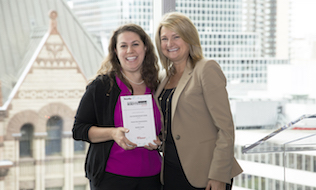
Coca-Cola Refreshments Canada learned the key to communication is using a medium and message that employees will understand, a lesson that secured the organization’s win for best pension communications at Benefits Canada’s 2018 Workplace Benefits Awards in Toronto on Oct. 11.
Whether using a high-tech channel like an online message or a low-tech method like a face-to-face meeting, the company brought pension information to employees in a variety of ways in order to leverage the communication option that worked best for each member.
“We tried to remove every barrier possible,” says Martha Callum, senior director of total rewards at Coca-Cola Refreshments Canada.
Read: Direct managers key to helping Coca-Cola manage DB/DC transition
The communication effort corresponded with several major changes in the company’s retirement benefits. In 2017, it transitioned from a defined benefit arrangement to a defined contribution pension plan. With nearly 6,800 employees spread across six manufacturing plants and 65 facilities, it has three employee populations — salaried, hourly and unionized — and manages 33 collective agreements and six different pension plan designs.
During the transition, the key messages for employees were fourfold, according to the award entry. First, the new program was aligned with Coca-Cola Refreshments Canada’s total rewards guiding principles, including a shared responsibility for creating a more consistent program across the country. Second, market trends were moving away from DB arrangements and towards DC plans. Third, the new program was part of an effort to ensure sustainability for retirement benefits, as well as for long-term career opportunities with the company. And finally, it was part of an effort to be a competitive player in the labour market, with an eye toward building cost-effective and financially prudent rewards programs.
With certain employees in DB plans and some already in a DC arrangement, the company had a great deal of detailed information to convey to members. It began the process by recognizing and subdividing communication strategies based on numerous, specific employee categories.
Read: Pension communication errors can lead to surprise costs for plan sponsors
Employees were identified by the multiple types of programs in which they were enrolled, including salaried or unionized DB, DC, as well as employees who’d moved from other affiliated or acquired companies. For example, in some of the legacy DC plans, employees weren’t required to make mandatory contributions, but this would change under the new plan.
As well, not all communication channels were open to all workers. Coca-Cola Refreshments Canada employs office, production and mobile workforces, which meant, for example, that 62 per cent of all employees don’t have access to a corporate email address.
Further, the company has multiple categories of workers, such as those on leave or those who operate under special conditions either through company policy or legislation. These groups often don’t have access to corporate email or the company intranet, which necessitated personalized, physical letters.
Read: How to avoid three common mistakes around pension, benefits communication
Workers also vary across timezones, working different shifts, which made it tricky to send out simultaneous announcements. In addition, employee demographics also affected what was appropriate to communicate. Younger workers, for example, generally have a higher risk tolerance when investing. Also, employees who’d previously been in DB arrangements never had to make investment decisions before so they typically have a lower pension literacy and would benefit from the simplification of some of the complex topics that go along with pension communications, noted the award entry.
And, since Coca-Cola is a high-profile company, it had to consider the optics to the general public of shifting its retirement benefits in any way that could be perceived as negative.
With all of this to consider, the communications rollout had to take a cascading approach, with certain employees informed of the changes before others. For instance, union leadership was briefed before certain announcements and managers were taught how to help their staff through the process in advance.
Coca-Cola Refreshments Canada launched its communications with an email from the company president, followed by webinars, online information, self-serve videos and multimedia guides. Within days of the announcements, employees began to receive face-to-face visits from human resources staff starting with the larger locations. This was followed by group presentations and then in-person chats with employees who were most affected.
Read: Woman’s DB dilemma a reminder of importance of clear communications
In measuring the strategy’s success, the company also focused on the impact of its communications. “We were thrilled with our participation rate,” says Callum.
The company set specific goals, which it outpaced. Some 84 per cent of DC members enrolled in the new program by its deadline, more than the 75 per cent the organization had targeted. Nearly all (99 per cent) of DB members enrolled. As well, 62 per cent of members chose to contribute the maximum amount to their pensions, well above the company’s goal of 50 per cent.
“The real key to getting those types of numbers was leveraging the managers and direct supervisors,” says Callum. “We found people who were in a position of trusted authority. Employees really responded when their direct manager or the head of their business line talked about it at team meetings.”
Read the full list of 2018 Workplace Benefits Awards winners here. And stay tuned in the coming days to learn more about each of the winners.
